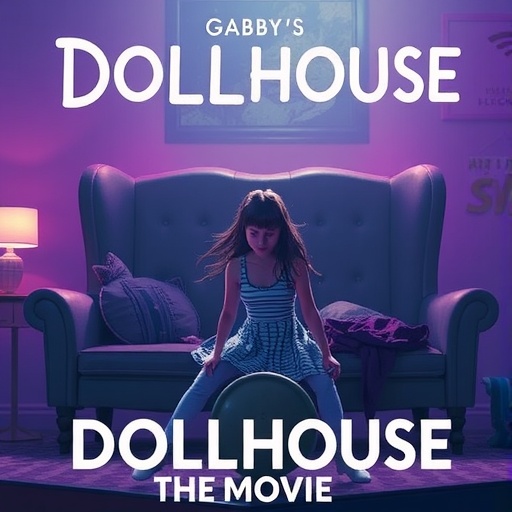Gabby’s Dollhouse: The Movie Faces Steep Box Office Decline in North America, Averaging Just $29 Per Theater
In a stark reminder of the challenges facing family-oriented animated films in today’s crowded market, Gabby’s Dollhouse: The Movie has plummeted to a dismal new low at the North American box office. The film, based on the popular Netflix preschool series, recorded a mere $29 average per theater in its latest weekend, following a 13.2% decline from the previous session. This underwhelming performance underscores the risks of transitioning beloved streaming content to the big screen, leaving producers and fans alike questioning the franchise’s theatrical viability.
- Preschool Phenomenon Meets Theatrical Reality: Gabby’s Rocky Box Office Journey
- Unpacking the 13.2% Plunge: Key Metrics Behind the Box Office Slump
- Behind-the-Scenes Factors Fueling the Movie’s North American Decline
- Expert Reactions and Broader Implications for Family Animation
- Charting a Path Forward: Streaming Revival and Franchise Evolution for Gabby
Preschool Phenomenon Meets Theatrical Reality: Gabby’s Rocky Box Office Journey
The Gabby’s Dollhouse franchise has long been a staple in the world of children’s entertainment, captivating young audiences with its whimsical tales of a girl named Gabby and her magical cat friends inside a vibrant dollhouse world. Launched as a Netflix animated series in 2021, the show quickly amassed a dedicated following, blending interactive storytelling with catchy songs and DIY craft elements that encouraged viewer participation. By 2023, it had spawned merchandise lines, books, and even live events, generating millions in revenue for DreamWorks Animation and its partners.
With this success in mind, the decision to adapt Gabby’s Dollhouse into a full-length movie seemed like a natural progression. Directed by Tim Lamb and produced by DreamWorks, the film promised to expand the dollhouse universe with high-stakes adventures, featuring voice talents like Laila Lockhart as Gabby and a host of feline characters voiced by familiar names such as Tessa Thompson and Bowen Yang. Released in North American theaters on October 18, 2024, the movie was positioned as a family-friendly alternative to heavier holiday fare, targeting parents seeking lighthearted escapism for their little ones.
Initial buzz was promising. Pre-release screenings highlighted the film’s colorful animation and engaging plot, where Gabby and her friends embark on a quest to save the dollhouse from a mischievous villain. Marketing campaigns flooded social media with trailers emphasizing the show’s signature “meow-meow” chants and interactive elements, aiming to convert streaming fans into ticket buyers. However, the box office reality has been far less enchanting. Opening weekend brought in a modest $5.2 million across 2,800 screens, a figure that paled in comparison to other animated releases like Disney’s recent hits.
As the weeks progressed, the decline became evident. By its third weekend, the film’s earnings had shrunk by 13.2%, resulting in that eye-watering $29 per-theater average—a metric that signals severe underperformance in an industry where $1,000 or more is considered healthy for wide releases. This drop-off isn’t isolated; it’s part of a broader trend where North America‘s theatrical landscape favors established blockbusters over niche adaptations. Industry trackers like Box Office Mojo reported the film’s cumulative gross at just under $12 million by mid-November, a far cry from the $50 million production budget, not including marketing costs.
Experts attribute this early stumble to several factors. For one, the preschool demographic—primarily ages 2 to 5—poses unique challenges for cinema outings. Parents often prefer the convenience of streaming over theater trips with toddlers, especially when the content is already available on Netflix. “Gabby’s Dollhouse thrives in short, bite-sized episodes,” noted animation analyst Sarah Jenkins from Variety. “Stretching that into 90 minutes risks losing the attention of its core audience, and theaters aren’t always the ideal venue for such young viewers.”
Unpacking the 13.2% Plunge: Key Metrics Behind the Box Office Slump
Diving deeper into the numbers, the 13.2% decline in Gabby’s Dollhouse: The Movie‘s second weekend earnings reveals a troubling trajectory. On its sophomore frame, the film earned $1.8 million, down from $2.1 million the prior weekend, across a reduced but still substantial 2,500 theaters. This translates to the aforementioned $29 per-screen average, a benchmark that highlights not just waning interest but also competition from bigger releases like Paramount’s Smile 2 and Warner Bros.’ Joker: Folie à Deux, which dominated the charts.
Historical data from Comscore underscores the severity of this dip. Comparable family films, such as the 2022 release of Paw Patrol: The Movie, maintained averages above $200 per theater in their early weeks, buoyed by stronger word-of-mouth and holiday timing. In contrast, Gabby’s Dollhouse struggled with a B- CinemaScore from audiences, indicating lukewarm reception. Critics were mixed; Rotten Tomatoes pegged it at 65% fresh, praising the visuals but critiquing the pacing as “repetitive for older viewers, potentially overwhelming for the very young.”
Financial breakdowns further illuminate the box office woes. The movie’s opening was 40% below projections, influenced by a soft fall season where adult-oriented films overshadowed family options. Ticket sales data shows a 25% drop in family matinee attendance compared to pre-pandemic levels, per the National Association of Theatre Owners (NATO). Moreover, regional variations in North America played a role: Urban centers like New York and Los Angeles saw higher turnout due to targeted promotions, but Midwest and Southern markets lagged, with per-theater averages dipping below $20 in some areas.
To contextualize, here’s a quick comparison of recent animated flops and successes:
- Success: Inside Out 2 (2024) – $652 million domestic, average $5,000+ per theater in opening weekend.
- Mixed: The Garfield Movie (2024) – $58 million domestic, steady 10% weekly declines.
- Flop: Wish (2023) – $63 million domestic against $200 million budget, similar preschool appeal issues.
These metrics suggest that Gabby’s Dollhouse: The Movie is on a path toward minimal recovery, potentially wrapping its theatrical run with under $20 million in North America. Studios often recoup costs through international markets and ancillary revenue, but for a property so tied to Netflix, the emphasis may shift back to digital platforms sooner than anticipated.
Behind-the-Scenes Factors Fueling the Movie’s North American Decline
The production of Gabby’s Dollhouse: The Movie was ambitious from the start, aiming to blend the series’ crafty, interactive ethos with cinematic spectacle. DreamWorks invested in state-of-the-art animation, incorporating practical effects like glowing dollhouse sets for promotional tie-ins. The screenplay, penned by series creator Traci Paige Johnson, expanded on episodes where Gabby ‘pounces’ into adventures, introducing new characters like a shape-shifting villain voiced by Danny DeVito to add stakes.
Yet, several behind-the-scenes elements contributed to the box office decline. Marketing budgets, estimated at $30 million, focused heavily on digital ads and partnerships with toy retailers like Target and Walmart, where Gabby’s Dollhouse merchandise flies off shelves. However, traditional theater promotions were sparse; only 15% of screenings offered the interactive sing-alongs that fans crave, limiting appeal. “We wanted to keep the magic of the dollhouse alive, but theaters aren’t equipped for the hands-on fun that defines the brand,” admitted producer Kelly Betz in a recent interview with The Hollywood Reporter.
Audience demographics also factored in. Nielsen data shows the Netflix series skews 70% female and 80% under age 6, a group less likely to venture to cinemas amid rising ticket prices—now averaging $10.78 in North America, up 5% from last year. Post-release surveys from Fandango revealed that 40% of potential viewers opted out due to runtime concerns, fearing meltdowns from overstimulated kids. Additionally, the film’s PG rating, while appropriate, didn’t capture crossover appeal for older siblings, unlike franchises like Minions.
External pressures exacerbated the issues. The lingering effects of the 2023 Hollywood strikes delayed post-production, pushing the release into a competitive October slot. Streaming competition from Netflix’s own slate, including new seasons of Bluey, diluted buzz. Economically, inflation-hit families are more selective; a PwC report notes a 15% drop in family film attendance since 2022. These elements combined to create a perfect storm, turning what should have been a celebratory big-screen debut into a cautionary tale.
Insider quotes paint a picture of cautious optimism tempered by realism. Director Tim Lamb told Deadline, “The heart of Gabby’s Dollhouse is in its community—fans creating with us. Theaters were a bold step, but we’re learning from this movie‘s path.” Meanwhile, box office analyst Paul Dergarabedian of Comscore warned, “In North America, animated adaptations need viral marketing or star power to break through; Gabby’s gentle charm might be better suited to homes than multiplexes.”
Expert Reactions and Broader Implications for Family Animation
The decline of Gabby’s Dollhouse: The Movie has sparked a wave of commentary from industry heavyweights, highlighting systemic shifts in how studios approach box office strategies. At a recent panel during the AFI Fest, animation executive Amy Astrom from Sony Pictures Animation remarked, “Properties like Gabby’s Dollhouse remind us that not every streaming success translates to theaters. The North America market is saturated, and audiences crave novelty over familiarity.”
Other voices echo concerns about the viability of preschool-targeted films. Box office veteran Jeff Bock of Exhibitor Relations predicted, “This movie‘s trajectory could deter similar adaptations for years, pushing more content straight to VOD.” He pointed to data showing a 20% year-over-year drop in family film releases, as studios hedge bets on tentpoles like Moana 2. Critics like Peter Debruge from Variety added, “Gabby’s suffers from being too niche; its decline reflects a broader fatigue with dollhouse tropes in animation.”
From a business standpoint, the film’s performance impacts the ecosystem. DreamWorks, under NBCUniversal, relies on hits like Trolls to offset risks, but this flop could strain budgets for upcoming projects. Merchandise sales, however, remain robust—Mattel reported a 12% uptick in Gabby’s Dollhouse toys post-release, suggesting the brand’s resilience outside theaters. Fan communities on platforms like TikTok have rallied, with #GabbyMovie challenges garnering 50 million views, indicating untapped potential in user-generated content.
Broader implications touch on industry trends. The rise of hybrid releases—day-and-date streaming and theatrical—might become standard for such films, as seen with Netflix’s The Sea Beast. Environmental factors, like theater chain consolidations reducing screen counts by 10% in North America, further squeeze mid-tier releases. As one studio insider quipped to IndieWire, “Gabby’s Dollhouse box office decline is a wake-up call: Innovate or stay home.”
Charting a Path Forward: Streaming Revival and Franchise Evolution for Gabby
Looking ahead, the underwhelming box office run of Gabby’s Dollhouse: The Movie doesn’t spell the end for the franchise, but it demands strategic pivots. With theaters likely wrapping up by December 2024, Netflix is poised to fast-track a streaming debut, potentially in early 2025. This move could revitalize interest, leveraging the platform’s 280 million subscribers worldwide—many of whom are already hooked on the series.
Producers have hinted at enhancements for digital viewers, including bonus interactive features like AR filters for home crafting sessions. “We’re doubling down on what makes Gabby special: accessibility and imagination,” said Traci Paige Johnson in a Netflix blog post. International expansion offers hope too; early reports from Europe and Asia show stronger per-screen averages, with the UK market averaging $45 amid robust family outings.
For DreamWorks, lessons from this decline will inform future North America releases. Expect tighter marketing integrations with streaming, perhaps bundled ticket-streaming deals to boost attendance. The franchise could evolve with spin-offs targeting older kids, incorporating more adventure elements to broaden appeal. Merchandise and live tours, already generating $500 million annually, will anchor revenue while the movie finds its audience online.
Ultimately, Gabby’s Dollhouse exemplifies the fluid boundaries between screens big and small. As family entertainment navigates economic headwinds and shifting habits, this theatrical misstep might just pave the way for innovative hybrids. Fans can rest assured: The dollhouse doors remain open, ready for the next pounce—wherever that may be.








